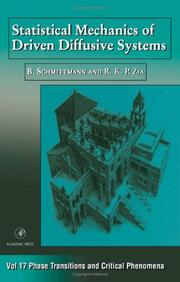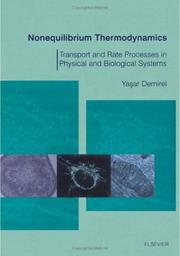| Listing 1 - 10 of 198 | << page >> |
Sort by
|
Book
ISBN: 0844816671 Year: 1990 Publisher: New York (N.Y.) : Taylor and Francis,
Abstract | Keywords | Export | Availability | Bookmark
 Loading...
Loading...Choose an application
- Reference Manager
- EndNote
- RefWorks (Direct export to RefWorks)
Book
Year: 2007 Publisher: Amsterdam : Elsevier,
Abstract | Keywords | Export | Availability | Bookmark
 Loading...
Loading...Choose an application
- Reference Manager
- EndNote
- RefWorks (Direct export to RefWorks)
Book
Year: 1969 Publisher: Washington, D.C. : National Aeronautics and Space Administration,
Abstract | Keywords | Export | Availability | Bookmark
 Loading...
Loading...Choose an application
- Reference Manager
- EndNote
- RefWorks (Direct export to RefWorks)
Book
ISBN: 9781108563055 9781108473729 1108563058 1108580467 1108679358 1108473725 Year: 2022 Publisher: Cambridge: Cambridge university press,
Abstract | Keywords | Export | Availability | Bookmark
 Loading...
Loading...Choose an application
- Reference Manager
- EndNote
- RefWorks (Direct export to RefWorks)
"This book provides a comprehensive and self-contained overview of recent progress in nonequilibrium statistical mechanics, in particular, the discovery of fluctuation relations and other time-reversal symmetry relations. The significance of these advances is that nonequilibrium statistical physics is no longer restricted to the linear regimes close to equilibrium, but extends to fully nonlinear regimes. These important new results have inspired the development of a unifying framework for describing both the microscopic dynamics of collections of particles, and the macroscopic hydrodynamics and thermodynamics of matter itself. The book discusses the significance of this theoretical framework in relation to a broad range of nonequilibrium processes, from the nanoscale to the macroscale, and is essential reading for researchers and graduate students in statistical physics, theoretical chemistry and biological physics."--
Book
ISBN: 1316981363 1316983951 1139017845 Year: 2017 Publisher: Cambridge, England : Cambridge University Press,
Abstract | Keywords | Export | Availability | Bookmark
 Loading...
Loading...Choose an application
- Reference Manager
- EndNote
- RefWorks (Direct export to RefWorks)
Written by two specialists with over twenty-five years of experience in the field, this valuable text presents a wide range of topics within the growing field of nonequilibrium molecular dynamics (NEMD). It introduces theories which are fundamental to the field - namely, nonequilibrium statistical mechanics and nonequilibrium thermodynamics - and provides state-of-the-art algorithms and advice for designing reliable NEMD code, as well as examining applications for both atomic and molecular fluids. It discusses homogenous and inhomogenous flows and pays considerable attention to highly confined fluids, such as nanofluidics. In addition to statistical mechanics and thermodynamics, the book covers the themes of temperature and thermodynamic fluxes and their computation, the theory and algorithms for homogenous shear and elongational flows, response theory and its applications, heat and mass transport algorithms, applications in molecular rheology, highly confined fluids (nanofluidics), the phenomenon of slip and how to compute it from basic microscopic principles, and generalized hydrodynamics.
Book
ISBN: 0387164898 3540164898 Year: 1986 Publisher: Berlin : Springer,
Abstract | Keywords | Export | Availability | Bookmark
 Loading...
Loading...Choose an application
- Reference Manager
- EndNote
- RefWorks (Direct export to RefWorks)

ISBN: 9780122203176 0122203178 9780080538747 0080538746 1281059323 9781281059321 9786611059323 Year: 1995 Publisher: London, [England] : Academic Press,
Abstract | Keywords | Export | Availability | Bookmark
 Loading...
Loading...Choose an application
- Reference Manager
- EndNote
- RefWorks (Direct export to RefWorks)
Far-from-equilibrium phenomena, while abundant in nature, are not nearly as well understood as their equilibrium counterparts. On the theoretical side, progress is slowed by the lack of a simple framework, such as the Boltzmann-Gbbs paradigm in the case of equilibrium thermodynamics. On the experimental side, the enormous structural complexity of real systems poses serious obstacles to comprehension.Similar difficulties have been overcome in equilibrium statistical mechanics by focusing on model systems. Even if they seem too simplistic for known physical systems, models give us considerab

ISBN: 9780444508867 0444508864 9780080479729 0080479723 128105092X 9786611050924 Year: 2002 Publisher: Amsterdam ; Boston : Elsevier,
Abstract | Keywords | Export | Availability | Bookmark
 Loading...
Loading...Choose an application
- Reference Manager
- EndNote
- RefWorks (Direct export to RefWorks)
The book begins with a brief review of equilibrium systems and transport and rate processes, then covers the following areas: theory of nonequilibrium thermodynamics; dissipation function; entropy and exergy; analysis and case studies on using the second law of thermodynamics; economic impact of the nonequilibrium thermodynamics theory; analysis of transport and rate processes; membrane transport; dissipative structures and biological systems; and other thermodynamic approaches and extended nonequilibrium thermodynamics.·Summarizes new applications of thermodynamics as tools for design
Multi
ISBN: 9780444530288 0444530282 9780080931968 0080931960 1282711563 9781282711563 9786612711565 Year: 2010 Publisher: Amsterdam ; Boston : Elsevier,
Abstract | Keywords | Export | Availability | Bookmark
 Loading...
Loading...Choose an application
- Reference Manager
- EndNote
- RefWorks (Direct export to RefWorks)
Thermodynamics of non-equilibrium processes is a comparatively new area of thermodynamics. Traditionally this discipline is taught only to chemistry students who have a very strong background in physics. The author of the present book has adapted his course of thermodynamics of non-equilibrium processes so that the subject can be treated in terms understandable to any chemist with a formal physicochemical education in the fields of classical thermodynamics of equilibrium processes and traditional chemical kinetics. The discipline combines thermodynamics and chemical kinetics and is
Book
Year: 2019 Publisher: London : IntechOpen,
Abstract | Keywords | Export | Availability | Bookmark
 Loading...
Loading...Choose an application
- Reference Manager
- EndNote
- RefWorks (Direct export to RefWorks)
All engineering processes are processes of non-equilibrium because one or all of heat, mass, and momentum transfer occur in an open system. The pure equilibrium state can be established in an isolated system, in which neither mass nor heat is transferred between the system and the environment. Most engineering transport analyses are based on the semi-, quasi-, or local equilibrium assumptions, which assume that any infinitesimal volume can be treated as a box of equilibrium. This book includes various aspects of non-equilibrium or irreversible statistical mechanics and their relationships with engineering applications. I hope that this book contributes to expanding the predictability of holistic engineering consisting of thermo-, fluid, and particle dynamics.
| Listing 1 - 10 of 198 | << page >> |
Sort by
|

 Search
Search Feedback
Feedback About UniCat
About UniCat  Help
Help News
News